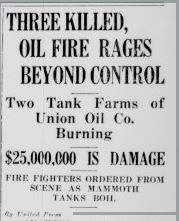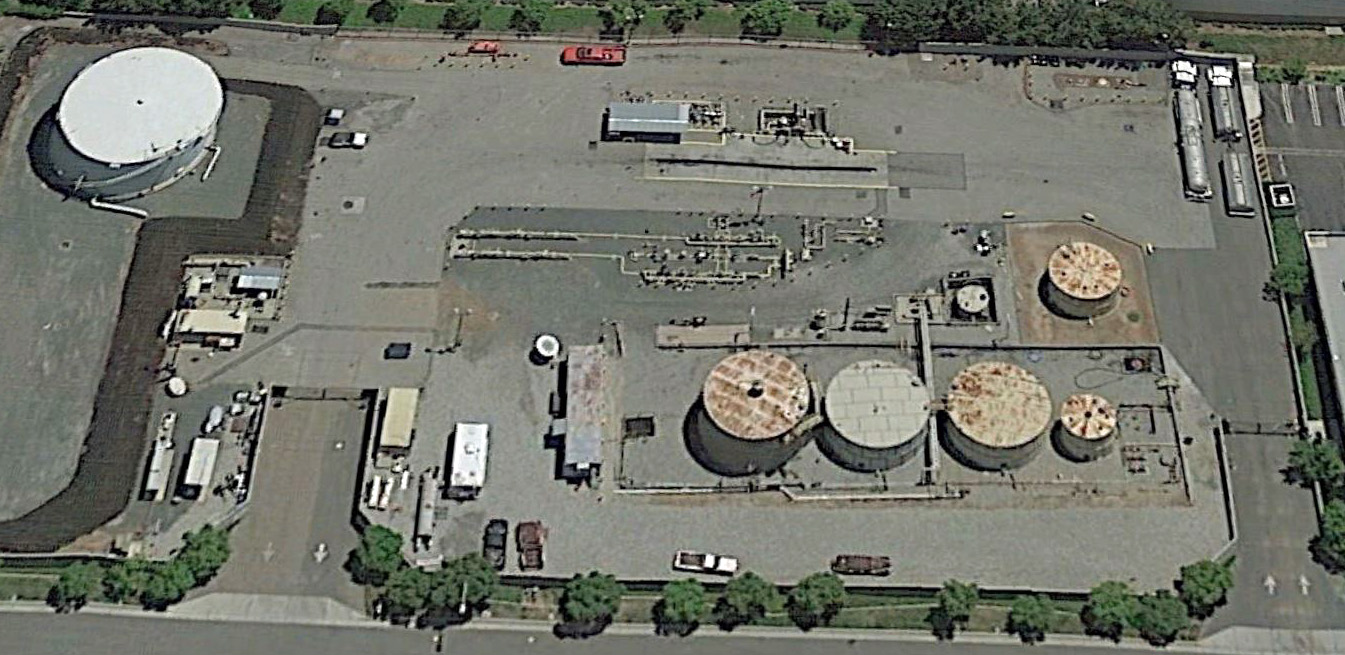Unocal Recruiting Booklet 1981
Unocal UCL Shale Oil Program 1982
Unocal Thailand Newsletter Jan-Feb 1992
Unocal Thailand Newsletter Nov-Dec 1992
Union Oil Tank Fires, April 1926


Thunderstorms with lightning are not common in southern California, but they do happen sometimes. April 1926 was one of those times.
In the book Oil, Orchards and Flames, firefighter Bill Nash described some of the events:
By 1926, Union Oil was building huge tanks and reservoirs, but it was concerned about what effect fire would have at one of these storage facilities. At 7:53 a.m. on April 7, 1926 it found out.
Three one million-barrel reservoirs at the San Luis Obispo tank farm were simultaneously ignited by lightning strikes. Fifteen minutes later, another lightning strike ignited a fourth reservoir. After burning out of control for 17 hours, the reservoirs boiled over and ignited a fifth reservoir and a row of steel tanks. The fires burned for days.
But the storm moved south, and the following day another lightning strike simultaneously ignited two million-barrel oil reservoirs in the Stewart Tank Farm, near Brea. A United Press story described the results:
April 8 – the Stewart tank farm near Brea was struck by lightning today and caught fire. Two tanks containing 750,000 barrels each were set on fire and the loss so far done has been estimated at $5,000,000. Volunteers were sent from Fullerton and Anaheim but could do nothing because boiling oil is showering like rain for several miles around the fire. The tank farm is owned by the Union Oil Company.
Both reservoirs were fired simultaneously with a loud explosion that was felt over a wide area.
Four other big storage vats adjacent to those already in flames also were in imminent danger, and several tanks of smaller capacity were endangered also.
This postcard shows a photo of the Brea fire: 
A word about terminology: When petroleum engineers use the word “reservoir,” they usually mean the underground rock from which oil and gas are extracted. But the Stewart Tank Farm had two types of oil storage: steel tanks, and large “oil reservoirs” like the one shown under construction in the photo below:

If you can see the detail in the photo above, you will note that the earthmoving equipment is powered by mules, typical of this kind of construction in the early part of the twentieth century. This kind of “ground storage reservoir,” with earth walls, would eventually have a wood and tarpaper roof. Unfortunately, that part of the structure was easily ignited by lightning. These ground storage reservoirs were big, holding 750,000 barrels or more.
In 2001, the Brea Historical Society newsletter published an interview with Mr. Walt Bergman, then 95 years old. In 1926, the Bergman family owned a garage in Brea. Mr. Bergman remembered standing at the corner of Birch and Brea Boulevard in downtown Brea, facing west. Suddenly he saw a “whole wall” of flame shooting into the air. He said the fire lasted a week, and that it was so bright that you could read a newspaper on Brea Boulevard in the middle of the night. He recalled that even at 2 AM the town of Brea was full of sightseers.
Further news from the fires:

That was the news story for the first day or two of the fires. The third person mentioned in the article above did die of their injuries, making the total 3 fatalities.
Another news story summarized what the fire destroyed:
“Three reservoirs, a small oil refinery, 70 acres of walnut and orange trees, three expensive ranch homes, and several houses on tank farm property were consumed by the flames."
Bill Nash summarizes the financial results after the whole story was known:
When the smoke finally cleared two weeks later, insurance appraised the damage as the greatest fire loss since the San Francisco earthquake fire of 1906. Nearly 8 million barrels of oil and 21 steel tanks were destroyed, and there was substantial damage to reservoirs, pumps, fittings and other equipment.
This aerial photo shows the fire and the rest of the Stewart Tank Farm, with an orange grove in the foreground, the town of Brea and the Brea oil field in the background:

The caption with the photo below says, “Looking North along Puente Avenue.” It seems that section of Puente Avenue, at that time, was a dirt road. Puente Street still exists in the west side of Brea, but the Stewart Tank Farm does not.

In the 1920’s, the Stewart Tank Farm covered a half-mile square. It was bounded by what is now Lambert, Berry, Puente and Central. The Stewart Pump Station still exists, with a very small footprint, accessed via Columbia Street off of Puente. It is owned now by Crimson Pipeline and it still gathers crude from nearby small fields and ships west to Wilmington area.
This image from Google Earth shows the Stewart Pump Station recently:

The photo below shows the fire from within the tank farm, probably after it had burned for several days.

All that was left of someone’s home was the chimney, surrounded by burned trees (an orange grove?)

This truck was too close to the fire:

So was this one:

As were these 2 cars:

Fireman Bill Nash, writing from the perspective of the 1990’s, says this about one of the outcomes of the two oil tank fires in 1926:
…Union Oil made a contribution to the fire service. This great fire led the company to develop its famous “fire lab” where firefighters could study the habits of fires, and practice putting them out. The company has instructed many municipal firefighters in oil-firefighting and continues to research ways to battle oil fires.

This photo shows a crew of students learning to fight oil fires the modern way, with protein-based foam.
[Thanks to Vern Grimshaw for contributing both knowledge and photographs for this article.]